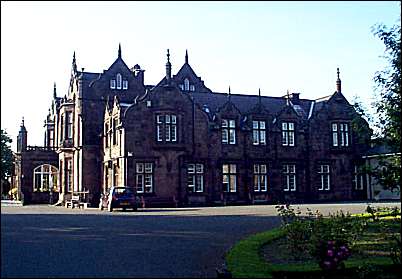The lie of the land on the west side of the Cellerhead to Leek ridge is
idyllic. It is a cascade of every kind of English landscape you could
wish for anywhere, from the outcrops of millstone at Wetley Rocks to
acres of purple moorland. On an earlier visit to the district I’d met up
with Staffordshire Moorland countryside officer Mark Preece who
maintains just how important Wetley Moor in particular still is.
“The 70 hectares of protected moor is a classified lowland heath which
represents ten percent of Staffordshire’s total,” he told me. “It is
indeed one of the highest valued nature conservations in England. But
about seventy-percent of Britain’s lowland heath has been lost in the past
200 years and it has become a threatened habitat for natural wildlife and
plant life.”
Wetley Moor had originally been classed as waste under the administration
of Hulton Abbey. There was at least a thousand acres of it in those times
much of it used for grazing. But along came industry and urban development
to change it all. It was here in the early 1800’s the Meigh potting family
took the best of the land on which they built an extraordinary mansion.
These days the estate has been broken up. But Meigh’s grand Ash Hall is
still standing, in use now as a residential nursing home owned by Geoff
Bowker and his two daughters Lorraine and Maxine.

The view of Ash Hall
from the entrance drive
“We bought the hall as a gamble eighteen years ago,” says Geoff age 70.
“My original intention was to develop it into a hotel with at least a
four-star status. But circumstances changed and we decided it would be
ideal as a nursing home. So I bought the whole estate. Sold some for
housing which gave me the collateral to make the main hall and the
extensive gardens into something special.”
Indeed he has done just that. Ash Hall, with its armorial motto Benigno
Numine (Heaven’s Favour) is a listed building and the gothic stone
exterior is exactly how the Meigh’s constructed it in the 1840’s. Inside
has been altered to reflect the changing periods. For instance the
original oak panelling has been replaced by maple sections sympathetically
designed in art deco character.
“It has seen a lot of changes since it stopped being a dwelling,” remarks
Geoff. “It had been used as offices in the main and much of the interior
had been sectioned off to make space for more rooms. I’ve kept some of
this because it suits my purpose. But the landings leading to the winding
staircase descending into the wide lobby is still much the same as the
original.”
Geoff’s is the archetypal rags to riches story that is representative of
Potteries’ grit and initiative. Brought up on a council estate in Abbey
Hulton, from the age of 11 he worked mainly in the building trade. After
his National Service he took his chances, and helped along by astute
financial partners went into house construction in a big way. He says he
got where he is by hard work and determination.
“I’ve always been a good earner me,” he explains his successes modestly. A
bit like the Meigh’s you might say.
![]()
![]()
![]()